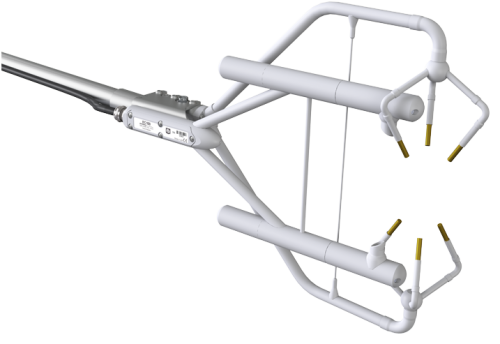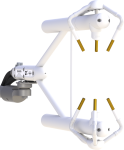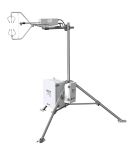
オープンパスの渦相関法システムの一部として、またはスタンドアロンのIRGAとして使用






概要
Campbell ScientificのEC150は、渦相関法フラックス測定用に特別に設計されたオープンパスアナライザです。スタンドアロンのアナライザとして、二酸化炭素と水蒸気の絶対密度、気温、気圧を同時に測定します。別売のCSAT3A超音波風速計ヘッドを使用すると、3次元的な風速と音波温度を測定できます。
続きを読む利点と特徴
- 新しいコンフォーマルコーティングにより、腐食環境でも音波トランスデューサを保護
- 独自の光学構成により、風による歪みを最小限に抑えたスリムな空力形状を実現
- アナライザと音波風速計の測定は、共通の電子回路で同期される
- 最大出力レート60Hz、帯域幅20Hz
- 低消費電力、太陽光発電アプリケーションに最適
- 低ノイズ
- アクティブな熱制御なしで温度補償された測定が可能
- 角度のついた窓で水を排出し、窓の汚れに強い
- 現場での堅牢性
- フィールドサービス可能
- CO2, H2O、圧力、温度の幅広い範囲で、実際に使用されるすべての組み合わせで工場校正済み
- 豊富な診断パラメータ
- Campbell Scientific社製データロガーとの完全な互換性:現場での設定、構成、ゼロ・スパンはデータロガーから直接可能
- 3つの音響経路から決定される音速;横風の影響を補正
- 革新的な信号処理と変換器ウィックにより、降雨時の風速計の性能を大幅に向上
イメージ













詳細
- Ux (m/s)*
- Uy (m/s)*
- Uz (m/s)*
- ソニック温度 (℃)*
-
音波診断*
-
CO2密度(mg/m3)
-
H2O密度(g/m3)
-
ガスアナライザ診断
-
周囲温度 (℃)
-
大気圧 (kPa)
-
CO2信号強度
-
H2O信号強度
- ソース温度 (℃)
*最初の5つの出力にはCSAT3A音波風速計ヘッドが必要です。
仕様
| 動作温度範囲 | -30° ~ +50°C |
| 校正圧力範囲 | 70 ~ 106 kPa |
| 入力電圧範囲 | 10 ~ 16 Vdc |
| 消費電力 | 5 W (定常状態および電源投入時) 25⁰C |
| 測定レート | 60 Hz |
| 出力帯域幅 | 5, 10, 12.5, 20 Hz (ユーザーによるプログラム可能) |
| 出力オプション | SDM, RS-485, USB, アナログ (CO2、 H2O のみ) |
| 補助入力 | 気温と気圧 |
| ガス分析装置/音波容積分離 | 5.0 cm (2.0 in.) |
| 保証 | 3年間または17,500時間の稼働 (いずれか早い方) |
| ケーブル長 | EC150およびCSAT3AからEC100まで3m(10フィート) |
| 重さ |
|
ガスアナライザ |
|
| パスの長さ |
15.37 cm (6.05 in.)
質量密度を濃度に変換するために、温度 20°C および圧力 101.325 kPa を使用。 |
ガスアナライザ - CO2 パフォーマンス |
|
| -注意- | 質量密度を濃度に変換するために、温度 20°C および圧力 101.325 kPaを使用。 |
| 正確度 |
|
| 精度RMS(最大) |
0.2 mg/m3 (0.15 µmol/mol)
精度検証テストの公称条件: 25°C、86 kPa、400 μmol/mol CO2、露点 12°C、帯域幅 20 Hz。 |
| 校正範囲 | 0 ~ 1,000 μmol/mol (0 ~ 3,000 µmol/moleリクエストに応じて利用可能) |
| 温度によるゼロドリフト(最大) | ±0.55 mg/m3/°C (±0.3 μmol/mol/°C) |
| 温度によるゲインドリフト(最大) | 読み取り値の±0.1% /°C |
| クロス感度(最大) | ±1.1 x 10-4 mol CO2 /mol H2O |
ガスアナライザ - H2O パフォーマンス |
|
| -注意- | 質量密度を濃度に変換するために、温度 20°C および圧力 101.325 kPaを使用。 |
| 正確度 |
|
| 精度RMS(最大) |
0.004 g/m3 mmol/mol (0.006 mmol/mol) 精度検証テストの公称条件: 25°C、86 kPa、400 μmol/mol CO2、露点 12°C、帯域幅 20 Hz。 |
| 校正範囲 | 0 ~ 72 mmol/mol (露点38℃) |
| 温度によるゼロドリフト(最大) | ±0.037 g/m3/°C (±0.05 mmol/mol/°C) |
| 温度によるゲインドリフト(最大) | 読み取り値の±0.3%/°C |
| クロス感度(最大) | ±0.1 mol H2O/mol CO2 |
超音波風速計 - 正確度 |
|
| オフセットエラー |
|
| ゲインエラー |
|
| 測定精度 RMS |
|
| 音速 | 3つの音響経路から判定 (横風の影響を補正済み) |
| 雨 | 革新的な超音波信号処理とユーザーが取り付け可能なウィックにより、あらゆる降雨状況下でも風速計の性能が大幅に向上します。 |
周囲温度 |
|
| メーカー | BetaTherm 100K6A1IA |
| 総合正確度 | ±0.15°C (-30°C ~ +50°C) |
ドキュメント
マニュアル
テクニカルペーパー
その他
- Improved Flux Measurements from Campbell Scientific Open-Path Gas Analyzers: Utilizing Sonic Temperature to Account for Spectroscopic Effects on CO2 Density
- Influence of Open-path Gas Analyzer Flow Distortion on Ultrasonic Wind Measurements
- Using Molecular Sieve to Zero Infrared Gas Analyzers for Eddy Covariance or Atmospheric Profile Measurements
- IRGASON and EC150 Source and Detector Cover Updates
ダウンロード
EasyFlux DL for CR6OP v.2.01 (98.2 KB) 21-07-2022
CR6 datalogger program for Campbell open-path eddy-covariance systems.
ECMon v.1.6 (10.7 MB) 29-03-2016
EC100-Series Support Software.
EC100 OS v.8.02 (560 KB) 14-10-2019
EC100 Operating System.
Watch the Video Tutorial: Updating the EC100 Operating System.
Device Configuration Utility v.2.33 (49.6 MB) 07-07-2025
A software utility used to download operating systems and set up Campbell Scientific hardware. Also will update PakBus Graph and the Network Planner if they have been installed previously by another Campbell Scientific software package.
Supported Operating Systems:
Windows 11 or 10 (Both 32 and 64 bit)
CSAT3H Heater Controller v.14.2 (46 KB) 02-02-2021
The CSAT3H Heater Controller ships with this encrypted program. This program is for the unlikely event that the program needs to be re-installed or updated to a newer version. Please contact Campbell Scientific if you have questions about the program or would like the algorithm modified for a specific application.
CSAT3H Heater Controller v.14.2 (46 KB) 02-02-2021
The CSAT3H Heater Controller ships with this encrypted program. This program is for the unlikely event that the program needs to be re-installed or updated to a newer version. Please contact Campbell Scientific if you have questions about the program or would like the algorithm modified for a specific application.
EasyFlux DL for CR1000XOP v.2.01 (98.2 KB) 21-07-2022
CR1000X datalogger program for Campbell open-path eddy-covariance systems.
よくある質問
EC150に関するよくある質問の数: 21
すべて展開すべて折りたたむ
-
EC150 および IRGASON® ガス分析装置のウィンドウは、表面に水が溜まらないように研磨され、斜めに傾けられ、疎水性材料でコーティングされています。また、毛細管現象を促進し、ウィンドウの端から水を遠ざけるために、ウィンドウにウィックを使用することもできます。また、スナウトのヒーターをオンにして、降雨や結露によるデータ損失を最小限に抑えることもできます。
-
IRGASON® または EC150 と CSAT3A の電力要件は、電源投入時または定常動作時にかかわらず、室温で 5 W です。極端に低温または高温の場合、電力要件は 6 W に達します。
-
工場出荷時の校正では、CO2 および H2O 信号強度は 0.7 まで考慮されます。したがって、データの品質を確保するには、信号強度が 0.7 未満に低下する前にウィンドウをクリーニングする必要があります。
-
はい。FW05 などの細線熱電対を使用できます。
-
どの気圧計を使用するかはユーザーが選択します。気圧計の精度レベルとコストには直接的な相関関係があります。
- 基本的な気圧計の正確度は、0° ~ 50°C の範囲で ±1.5 kPa です。0° 未満では、誤差は直線的に増加し、-30°C では ±3.7 kPa になります。
- 高精度気圧計は、±0.15 kPa (-30° ~ +50°C) の正確度を提供します。
気圧計を選択するときは、圧力精度がフラックス計算に与える影響を考慮してください。顕熱フラックスの場合、気圧は空気の密度を計算するために使用され、それが顕熱フラックスを直接スケーリングします。したがって、気圧の測定値が 1% ずれると、顕熱フラックスも 1% ずれます。
CO2 フラックスについては、EC150 と IRGASON® は CO2 を密度として報告します。したがって、気圧はフラックスの直接計算には使用されません。ただし、圧力測定の誤差により、CO2 スパンから生じる CO2 フラックスに誤差が生じる可能性があります。スパン手順中に、ユーザーは「真の CO2 値」を CO2 濃度として入力し、後で気圧を使用して密度に変換します。その結果、CO2 測定の誤差は気圧測定の誤差に正比例します。
-
IRGASON® と EC150 は工場で温度範囲 (-30° ~ +50°C) と気圧範囲 (70 ~ 106 kPa) にわたって校正されているため、気圧計と温度センサが必要です。
-
ゼロ/スパン調整を行う頻度は、現場の状況に大きく依存しますが、ゼロ/スパン調整を月に 1 回行うのがよい出発点です。一般的なガイドラインとして、時間の経過に伴う機器の光学ドリフトを監視して、ゼロ/スパン調整手順を実行する頻度を決定します。
-
工場の再校正は必要に応じて行われます。診断フラグが表示され始め、分析装置をクリーニングして設定を確認した後も消えない場合は、再校正が必要です。さらに、分析装置のパフォーマンスが低下している場合は、再校正をお勧めします。
パフォーマンス テストの 1 つは、1 年間の絶対信号強度ドリフトをチェックすることです。1 年に数パーセントのドリフトは正常です。年間の信号強度ドリフトが過度の場合、またはウィンドウがきれいなときに信号強度が 0.7 を下回る場合は、工場の再校正が必要です。さらに、CO2 と H2O の信号強度の比率が 1 に近くない場合も、工場の再校正の時期である可能性があります。
-
IRGASON® および EC150 の共通アクセサリとして販売されているオープンパス渦共分散プログラムは、時系列テーブルで生データを作成し、30 分間のフラックス テーブルで推定フラックスを作成します。推定フラックスは、密度の影響について Webb、Pearman、Leuning (WPL) 補正を受けています。音速温度も湿度の影響について補正され、顕熱フラックスの推定に使用されています。データは後処理中にさらに補正を受ける必要がありますが、これらの推定フラックスは、センサが適切に動作し、妥当な結果を提供しているかどうかについて即座にフィードバックを与えるため、現場で役立ちます。
Campbell Scientific は、結果の公開前に、生の時系列データを適切な補正をすべて行った後処理を強く推奨します。
-
IRGASON® または EC150 の最小高さは約 2 m にする必要があります。この高さより下にセンサを配置すると、周波数応答が大幅に低下する可能性があります。最大高さは、利用可能な風上フェッチまたはフットプリント領域によって異なります。不安定な境界層条件の一般的なガイドラインとして、センサの高さは、センサからフットプリント領域の最外縁までの距離を 100 で割った値よりも小さくする必要があります。たとえば、利用可能な風上フェッチが 500 m の場合、IRGASON® または EC150 の高さは 5 m を超えてはなりません。中立で安定した条件の場合、フットプリント領域は拡大することに注意してください。
ケーススタディ
科学者や土地利用管理者は、炭素吸収における森林地帯の重要性を長い間認識してきました。研究と国際政策は主に熱帯林と生息地に焦点が当てられてきました。熱帯林と生息地は成長が早く、頻繁な伐採の影響を受けやすいためです。しかし最近では、安定的に炭素を吸収して貯蔵できる生息地が地球全体の炭素状況の重要な部分であると認識されるようになり、寒帯地域などの冷涼な気候の景観に研究の焦点が当てられるようになりました。これらの地域では成熟した森林と気温によって分解速度が制限されるため、気候変動がこれらの景観を変える潜在的な影響により、景観をより完全に理解するための取り組みが強化されています。 アラスカ大学フェアバンクス校の研究者らは、米国地質調査所の資金援助を受け、国立科学財団の長期生態学研究ネットワークの一部であるボナンザ クリーク実験林内の 3 か所の環境モニタリング サイトに機器を設置しました。これらのサイトは、微気候の違いによって決まる陸上北方景観の重要な生息地を代表する永久凍土の劣化の年代順に位置しています。3 つのサイトには、クロトウヒ林 (クロトウヒの森がそのまま残っている安定した永久凍土の地域)、永久凍土が下にある地表の氷が溶けて樹木がかなり枯死している活発なサーモカルスト サイト、活動層の深さが深く安定した樹木のない湿原サイトが含まれます。 このプロジェクトの目標は、北極圏の気候システムにおける地表、大気、海洋間の重要なつながりとフィードバックである炭素、水、エネルギーのフラックスを年間を通じて継続的に測定することです。これまで、北極圏では環境条件が厳しく、遠隔地へのアクセスが困難なため、このような研究はほとんど行われていません。冬季に太陽光発電が限られ、風力発電が実行可能な選択肢ではない場所で継続的に監視するには、電力要件が極めて低く、リモート システム診断機能を備えた堅牢なセンサーを選択する必要があります。 Bonanza Creek サイトで、渦相関フラックス測定に Campbell Scientific の EC150......続きを読む
Privacy Policy Update
We've updated our privacy policy. 詳細はこちら
Cookie Consent
Update your cookie preferences. クッキーの設定を更新する








